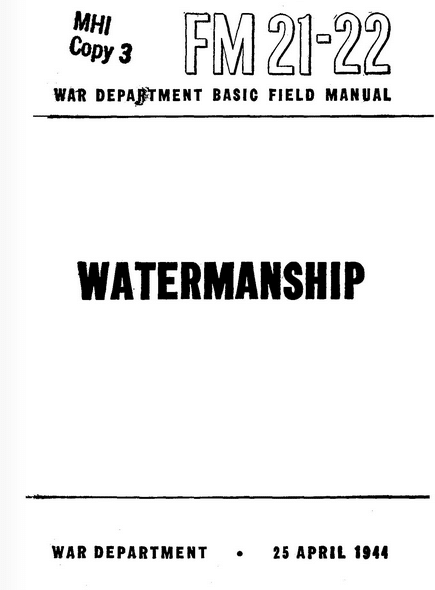
Editor’s note: In 1944, the US War Department published FM 21-22, a manual on military watermanship. The manual covers everything a man needs to know to survive at sea, from how to properly abandon a sinking ship to how to stay alive in a lifeboat. This week we’ll be highlighting several of the manual’s sections; the information is both fascinating from a historical standpoint and useful for worst case scenarios.
FM 21-22 War Department Watermanship Manual, 1944
Living Aboard Life Craft
GENERAL.
Once you are safely aboard a life craft, whether a ship’s lifeboat or float, your chances of being rescued are increased considerably. Remember that rescue parties start out immediately the ship’s sinking is made known. Until rescued, make the most of living with limited physical comforts and in crowded quarters. Survival depends on everyone carrying out routine tasks cheerfully and promptly; sharing hardships equally and without complaint.
a. Command. Command aboard lifeboat is assigned and takes precedence over rank. If boat commander becomes a casualty or in the absence of an assigned commander, the next senior officer or senior noncommissioned officer aboard then assumes command.
b. Responsibilities of command. The responsibilities of a boat commander are very great. He should appoint at least two others as his assistants. Almost everything depends on the bearing and conduct of the men in charge. They must be able to assume responsibility, enforce strict discipline, assign jobs, deal with emergencies, and take charge of rations, navigation, and boat work. Some of the specific duties of this command are to:
(1) Place a man in charge of all arms and ammunition as a precaution against insanity or mutiny.
(2) Place a man in charge of all water and provisions as a precaution against contamination, spoiling, and pilferage.
(3) Assign tasks to all men except those severely exhausted or seriously wounded.
(4) Arrange living and sleeping accommodations.
(5) Divide all equipment, whether general or personal, to obtain an equal share of comfort.
(6) Ration water and food.
(7) Arrange suitable diet for each person per day — depending on the provisions aboard.
(8) Schedule the number of meals and time for each.
(9) Examine all equipment aboard for serviceability; supervise repairs.
(10) Set a definite course and maintain it.
(11) Take charge of first-aid equipment and supervise administration of first aid.
(12) Maintain morale and faith; schedule and conduct or supervise regular periods of worship if circumstances permit.
CARE OF EQUIPMENT.
a. Boat’s equipment. Lash down everything aboard. Nothing should be discarded unless sure it will be of no further use. Try to keep all equipment as dry as conditions permit. Every effort should be made to dry the boat and keep her so.
b. Clothing. As soon as possible, squeeze out all your wet clothing but do not take off all your clothes unless the weather is warm and dry, with a moderate wind. Undress and dry clothes layer by layer.
WATER.
a. General. Water is the most important item for survival. Man can exist only about 7 days without water. Loss of body moisture is hastened by heat and exercise. Do not drink salt water as it will cause diarrhea, weakness, and unbearable thirst. Delirious men may have to be forcibly restrained from drinking salt water. Never drink urine; never forget this. If water is not available do not eat. Elimination of food wastes absorbs water from the kidneys and decreases water in the body.
b. Sources.
(1) Boat’s supply. This is the primary source of drinking water. To keep water from freezing in breaker, remove the plug. Insert a stick in the breaker. The lower end of stick should be weighted and upper end should protrude a foot or more. Movement of boat will keep the stick in motion so ice will not be able to form.
(2) Canteens. All canteens are commandeered by the boat’s commander and the water in them made a part of the boat’s supply.
(3) Rain water. Use cups, tin cans, sea anchor, boat cover, sails, strips of clean clothing, and all canvas gear in the boat to collect rain water. Be sure this equipment is free of salt; wash it off with the first fall of rain.
(4) Ice. In the cold regions icebergs are a source of fresh water. In freezing weather, fresh water can be obtained from sea water. Collect some sea water in a container. The fresh water will freeze first. The salt will collect in high concentration as slush in the core of the frozen piece. Remove the ice and throw away the slush. The melting ice will produce water sufficiently free of salt to sustain life. “Old” ice also is a source of fresh water. It has rounded corners due to rains and thaws, is bluish in color, has a glare, and splinters easily with a knife.
(5) Chemical kits. Chemical kits may be provided in boats or rafts to remove the salt and alkaline from salt water.
(6) Coral-reef water. On coral reefs brackish water suitable for drinking can be found by digging a 6-inch hole, 6 to 8 inches deep. Surface water will collect after a short time. Do not dig deeper because you will penetrate the layer of fresh water and reach salt.
c. Storage. Water is stored in every container that might be utilized for this purpose. It also may be stored in carbon dioxide life jackets and in the lifeboat’s air tanks.
d. Issue.
(1) An inventory is taken of all water aboard. Plan the issue of water with regard to all circumstances present: total supply of water, number of men in lifeboat, time likely to be adrift, chances of replenishing supply, and the extra water needed for the sick and wounded.
(2) The average ration is 18 ounces — 3 cups. A gallon contains 128 ounces. To compute the number of days the water will last, divide the total ounces of water by 18 and divide this by number of men in the boat. For example:
Amount (quarts) of water equals 15 times passenger capacity of boat (marked on sides); 15 passengers for example; 14 passengers actually present.
15 X 15 = 225 quarts
225 / 4 = 56 gallons
56 gallons X 128 ounces = 7,168 ounces
7,168 ounces / 18 ounces (ration) = 398 rations
398 rations / 14 men = 28 days
(3) Control of issue starts immediately and continues until survivors are rescued.
FOOD.
a. General. A responsible person must be put in charge of all food supplies. He must divide all food fairly and schedule the meals. A complete inventory of provisions must be taken before any food is distributed. On dry days the food should be checked to see what is on hand and if anything has spoiled. Special food should be kept to bolster morale in gloomy periods. In one lifeboat from the Robin Moor, biscuit crumbs, moistened with cold water, seasoned with sea water and mixed with canned tomatoes provided a feast which raised morale considerably.
b. Sources.
(1) Boat’s supply. This is the principal source of food supply. Refer to manual for the provisions allotted to lifeboats and rafts.
(2) Fishing. Fish can be caught with the equipment in the fishing kit or with improvised gear.
(3) Birds. All birds are good to eat, cooked or raw. Their blood and livers are also edible. Catch every bird you can. Use the feathers to make fishing jigs or stuff them under your clothing for warmth.
(4) Seaweed. Certain kinds of seaweed may be eaten but not unless you have plenty of water. Chew it well. Seaweed often holds small fish which can be eaten. Lift it out of water slowly and shake it inside of boat. Discard jelly fish, which are poisonous, and crabs, which are too salty.
c. Issue. Control of issue starts immediately and continues until survivors are rescued.
(1) Ration calculations. To calculate rations, first estimate the number of days before rescue is expected. By dividing this number into the amount of each item of food, the daily ration of each is found. In a boat loaded to capacity there are 56 ounces of food, or about 8,000 calories, for each man. Provisions weigh as follows:
- 1 biscuit equals 1/2 ounce; total 56 biscuits.
- 19 malted-milk tablets equal 1 ounce; total 226 tablets. (Suck tablets slowly; do not chew them.)
- 1/4 can of pemmican equals 1 ounce; total 4 cans. (Pemmican is concentrated meat; eat pemmican and biscuits together.)
Example: If rescue is expected within 10 days, the ration for 1 day will be:
- 5 biscuits.
- 22 malted-milk tablets.
- 2/5 of a can of pemmican.
This equals about 5.6 ounces per day, giving a diet of about 800 calories, sufficient to sustain life.
(2) Eating rations. Eat slowly and chew thoroughly. Emergency rations should be taken several times a day in small portions.
FISHING.
a. Practically all freshly caught sea fish are palatable and wholesome, cooked or raw. In warm regions fish should be bled and gutted immediately after catching. Fish not eaten immediately should be cut in thin narrow strips and hung to dry in the air and sun. Fish not cleaned and dried may spoil in half a day. Never eat a fish that has pale slimy gills, sunken eyes, flabby skin and flesh, an unpleasant odor, or whose flesh remains indented when pressed by the thumb. Good fish should have pink or red gills, bright clear eyes, firm flesh, and be free from stringy slime. Sea fish should also have a saltwater tang or clean fishy odor.
b. Poisonous fish are sometimes found in the tropics. The bodies of these fish are covered with rough or spiny scales, with thornlike spines, or with bony plates. In one poisonous variety the skin is naked or is strewn with soft spines or bristles which look like hair. None have the ordinary scales found on bass, trout, snappers, groupers, and goldfish. Follow this rule: If it does not look like an ordinary fish, if it has unusual appendages, if its mouth looks unusual or lacks teeth, if it is not covered with ordinary fish scales, let it alone. Remember that fresh, nonpoisonous, salt-water fish can be eaten raw; fresh-water fish cannot.
c. Fish are attracted by light and may jump into the boat toward a flashlight or the reflection of the moon on a white object hung in the boat.
d. The whole meat, blood, and juice of a turtle are edible. Hot sun brings out of turtle fat a clear oil into which food may be dipped. Turtles can be snagged with a hook or turned on their backs and towed in. However, even after a turtle’s head has been cut off, the mouth may bite and the claws may scratch.
e. Eels are fish and good to eat but do not confuse them with sea snakes. Unlike eels, sea snakes, found in the Pacific and Indian oceans, have scales and swim on the surface of the water.
SLEEP.
a. While it is possible to do without sleep for long periods, it is far better to get regular sleep. If you feel cold, crowd together under a canvas cover forward or in a sail cloth or blanket. In calm weather make more room in the boat by lashing oars and spare gear outboard along the gunwale.
b. It may be dangerous to drop off to sleep in a Carley float because risk of drowning is thereby increased. Stay awake as long as possible in extremely cold weather.
CONSERVATION OF STRENGTH.
a. Every member of the lifeboat’s company possesses a store of energy which, if used, is not likely to be replaced by the rations provided in the boat. Do not waste this strength by useless exertion or by the development of a bad frame of mind.
b. Some suggestions for the conservation of strength follow:
(1) Do not exhaust yourself by getting excited.
(2) Do not sing or shout.
(3) Take mild exercise such as a short turn at the oars to prevent body from kinking up.
(4) In hot weather, work on the boat should be done before the sun is up.
(5) It is never justifiable to attempt to make progress by continuous pulling at the oars. Periods of 15 minutes at the oars with 1 hour rest will permit steady progress for long periods with minimum exhaustion.
CARE OF SICK AND WOUNDED.
a. Special care should be given to the sick and wounded. Lash weak or badly injured men to the boat to prevent their rolling about in the boat. If a flat surface is needed for wounded men, several oars can be laid side by side in the boat or across the gunwales. Life preservers make a satisfactory bed. Post a man to prevent the sick from attempting to go over the side; they sometimes imagine they are back home or in the ship. Humor them at all times.
b. In case of death, the victim’s clothing and equipment should be removed before burying the body at sea.
PROTECTION AGAINST WEATHER.
a. Protection against cold winds, rain, and spray. If canvas hood and side spray curtains are available, put them up as soon as possible. In freezing weather a blanket dipped in water and allowed to freeze will provide shelter against spray and wind. Sometimes these measures will not give sufficient protection and you will have to share blankets and huddle together to keep warm. In wet weather, keep waterproof clothing on even if clothes underneath are wet.
b. Protection against sun and heat. Rig up an awning if possible and try to provide some cover for the man at the tiller. Do not take off too many clothes; they will protect your skin against sunburn. This also applies to legs and feet, which should be covered or in the shade. Even in cloudy weather you can get badly sunburned. Protect eyes from glare of sun by improvising some kind of eyeshade. Tie a cloth or bandage over nose; this will cut off glare from the water when you are looking straight ahead.
NAVIGATION.
a. General. Before the ship is abandoned, its location and the direction and distance to land are given to all men aboard. Lifeboats contain simple navigation charts and a compass. Try to reach a sea or air route where there is greater chance of being rescued. If the sea and air routes are not known, it is best to set a course east or west. Keeping on the move helps maintain morale. If a compass is not available, determine direction from the sun and stars.
b. Determination of direction by using watch and sun.
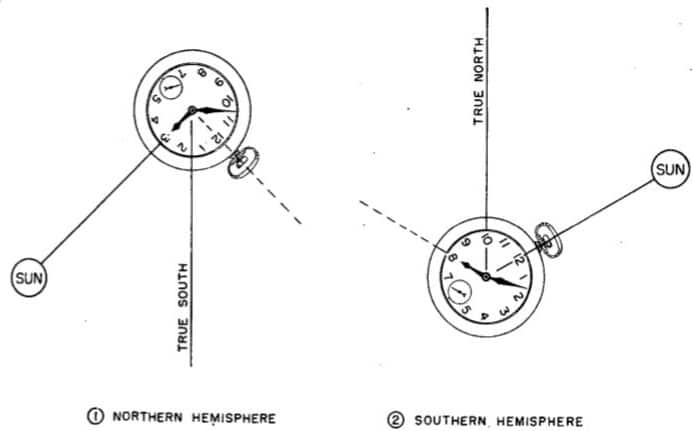
Using watch and sun to determine direction.
When the sun is visible, a watch can be used to determine true south or north with an error of less than 8 degrees. This method is difficult when the sun is high and is of little or no use in the tropics; furthermore, the watch must be on standard time. If it is subject to corrections for war time, daylight saving time, or zone time, it must be set back accordingly.
(1) In the northern hemisphere, turn the watch face up, and point the hour hand at the sun. To aid in correct pointing, hold vertically a pencil or other straight, slender stick so that it casts a shadow across the face of the watch. Rotate the watch to bring the hour hand into this shadow. Draw a line from the center of the watch dial through the midpoint of the smaller arc between the hour hand and 12 o’clock on the watch face. This line points toward true south.
(2) In the southern hemisphere, point toward the sun the 12 o’clock mark on the watch. North lies halfway between this mark and the hour hand.
c. Determination of direction by stars.
(1) Northern hemisphere. In the northern hemisphere, the North star, Polaris, is the best star for finding direction. This star is almost vertically above the North Pole and any sight on it is within 1 degree of true north. The following are methods of identifying Polaris:
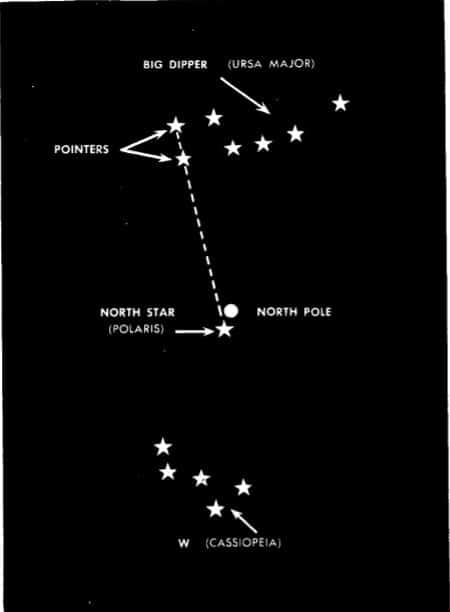
Relation of Big Dipper and W to North Star.
(a) By means of the Big Dipper. The Big Dipper is a star group easily recognized by its shape. The two stars forming the side opposite the handle are called pointers, because a line through them always points to the North Star. From the lip of the Big Dipper to the North Star is about 5 times the distance between the pointers.

Using the Big Dipper and fingers to locate North Star.
Anyone having difficulty in locating the North Star can do so by using the fingers. Hold one finger in front of the eye, and adjust its distance from the eye until one pointer is at each side of the finger. Add five more fingers. The North Star then is just outside the last added finger and on a line with the pointers. Once identified it is easily recognized by its brightness in comparison with the other stars nearby.
(b) By means of Cassiopeia (W). When the Big Dipper is not visible, another star group may be used to identify the North Star. On the opposite side of the North Star, and at about the same distance from it as the Big Dipper, is a group of five stars, called Cassiopeia, which forms the letter W, or M if the group is above the North Star. The relation between the North Star and the W is pictured above. This should be memorized.
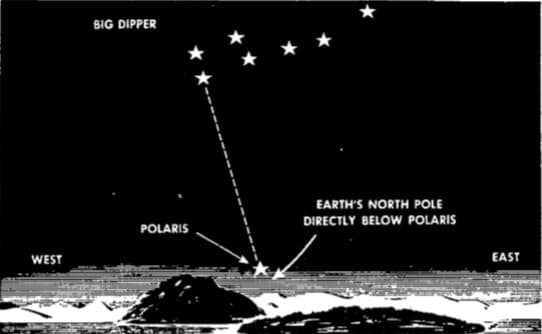
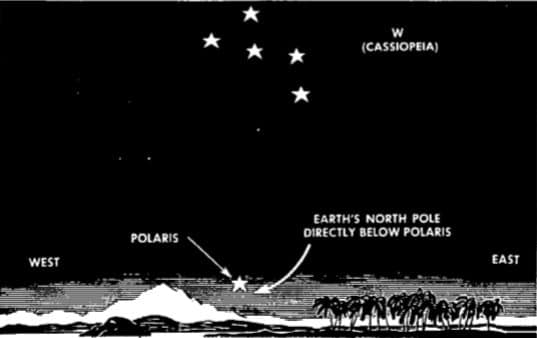
View of North Star, Big Dipper, and W from Equator.
(2) Behavior of stars. At the North Pole, the North Star appears directly overhead, and both the Big Dipper and W are visible and seem to rotate around the North Star. To one going south from the North Pole toward the Equator, these stars appear to lose elevation; they are seen nearer the horizon. The 40th parallel of north latitude, which passes through Pennsylvania, Spain, Greece, and Japan, is the most southerly point from which both the Big Dipper and W are always visible. South of this parallel only one of these star groups is visible at a time; so half the time it is identified by the Big Dipper. And half the time by W.


Relation of Southern Cross, “pointer stars,” and celestial South Pole.
(3) Southern Hemisphere. There is a faint star called Sigma Octantis above the South Pole and 1 degree from it. However since it is sometimes difficult to recognize and use this star, the Southern Cross is usually used to determine direction. Four bright stars form the cross. It is identified by its shape and relative brilliance, and by the two bright pointer stars. The Southern Cross appears to rotate about the South Pole just as the Big Dipper seems to rotate about the North Pole, but in the opposite direction. The groups are about the same distance from their respective poles. To locate the South Pole, consider the Southern Cross a kite. Extend its long axis 4.5 times in the direction of the tail. The point in the sky thus fixed is approximately over the South Pole. Use this point for true south direction. Under favorable light conditions the South Pole star may be identified and used. From the vicinity of the Equator, both the Southern Cross and the Big Dipper are sometimes visible, sometimes only one of them. When both are visible, they are about equally high above the horizon, but in opposite parts of the sky. As one moves south from the Equator the Southern Cross becomes visible for a greater part of the night. South of the 33rd parallel of south latitude, which runs through Uruguay, Cape of Good Hope, and Southern Australia, the Cross is visible all night. For night observation south of the Equator, where the South Pole star cannot be identified and the Southern Cross is not continuously visible, the following procedure may be used. Determine direction at sunset just before the Southern Cross disappears by methods already described. Then select a star in the vicinity of the South Pole, preferably one just rising, and memorize the appearance and position of this star. Use it to maintain direction for the remainder of the night.
d. By rising and setting of sun. Observe the times of rise and set of sun on the same day, or the time it sets one day and the time it rises the following morning. Divide by 2 the time elapsed between rising and setting. In the northern hemisphere the answer, added to the time of the sun’s rise, will give the hour when the sun is true south.
Example:
Sunrise 0600
Sunset 1900
(1900 – 0600) / 2 = 0630
0600 + 0630 = 1230, time sun is at true south.
The same procedure applies for the southern hemisphere, except that the direction to the sun is true north.
PHYSICAL INDICATIONS OF LAND.
a. General. The following paragraphs describe certain signs that will aid the alert helmsman in steering toward land. These signs will not of themselves be positive evidence of the proximity of land; yet, correlated with other observations, they will strengthen the probability of finding land nearby.
b. Clouds. Clouds and certain distinctive reflections in the sky are the most reliable indications of land.
(1) Small clouds hover over and a little to lee side of atolls. Color of lagoon is sometimes reflected from the clouds and indicates an atoll beyond the horizon.
(2) Small clouds may also hover over coral patches and hidden reefs thus acting as warnings of shoals.
(3) Fixed clouds or cloud crests often appear around the summits of hilly islands or coastal land. Fixed clouds are easily recognized by moving clouds passing by them.
(4) Lights from cities are usually reflected in the sky, especially by high clouds.
(5) In tropical regions, lightning from one particular direction in early hours of morning is usually a sign of mountainous land.
(6) In polar regions, a sharply defined patch of brightness in otherwise gray sky is a sign of areas of floe or shore ice in the midst of open water.
c. Sounds. Sound from land is affected by the strength and direction of the wind. This fact must be applied to any sound from land to be useful to the navigator. By shutting the eyes and turning the head to get equal volume of sound in each ear, it is possible to obtain close approximation of bearing of the sound.
(1) Continued cries of sea birds from one particular direction signify roosting place on land.
(2) In fog, if ship’s whistle or siren is heard, vessel is moving; but if bell is heard at regular intervals, the sound is coming from a ship at anchor or from a bell buoy.
d. Birds and insects. An increase in the number of birds and insects indicates land nearby.
e. Odors. Land odors are carried out to sea by the wind. Detection of such odors in fog, mist, rain, or at night is very important as you may be drifting past a nearby shore without seeing it.
WATCH.
Maintain a continuous watch aboard lifeboat, raft, or float. This duty is similar to sentry duty. The man on watch (sentry) looks for rescue parties, steers the boat to prevent its capsizing, maintains designated course or changes it as necessary, and informs the boat commander of all that has occurred during that watch. This duty is rotated and should be shortened as necessary when the boat’s company becomes exhausted.
ATTRACTING ATTENTION.
Do not waste signaling equipment on the chance someone may see your signal. A real chance of being rescued may be lost a few hours later. In the absence of such equipment, make yourself conspicuous by churning up the sea with oars or paddles. If an airplane is heard in the vicinity, wait until it is heading in your direction and fairly close to you before firing a signal. Remember, you can hear an airplane long before you can see it or the airplane’s crew can see you. Be prepared to fire a second signal to confirm the first. Be sure you are signaling a friend, not an enemy.
RESCUE AT SEA.
a. Rescue at sea is the transfer of survivors from one craft to another; it is nothing short of that. Failure to recognize this will result in additional hazards to the survivors.
b. Order must be maintained and navigation on a chosen course must continue without interruption even if land or rescue parties are sighted. Though land is sighted a boat may drift away before she can be beached; rescue parties which you see may not see you, may turn out to be other survivors unable to help you, or may be enemy craft. Remember the following points:
(1) Don’t change your course to reach a sighted craft. If it is a friendly rescue party it will make for your craft and probably be in far better circumstances to do so.
(2) Don’t drink up all the water and eat all the food even if it appears that rescue is possible.
(3) Don’t consider yourself rescued until you are actually aboard the other craft or are placed under the orders of her commander.
Read the Entire Series
Survival Swimming
How to Climb Down a Ship’s Ropes and Cargo Nets
Abandoning Ship


